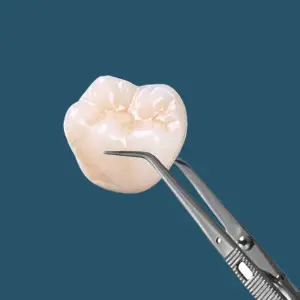The Dental Crown Procedure: Before, During, and After the Treatment
A dental crown is a tooth-shaped cap placed over a tooth to restore its shape, size, and strength. Crowns can be made from various materials like porcelain, ceramic, metal, and resin.
If your tooth is extensively damaged, a crown is generally effective to protect and strengthen it. The crown procedure involves several steps—from impressions to temporary crown placement to cementing the permanent crown. Here’s a complete walkthrough.
What Is a Dental Crown Procedure?
While dental implants are different from crowns, they both are used to replace or restore a missing or compromised tooth. A dental crown caps a weakened tooth to protect and reinforce it. It can be placed for cosmetic reasons or to prevent a cracked tooth from further damage.
The procedure begins with reshaping the tooth to make room for the crown. Impressions are taken to create a temporary and then a permanent crown. The dentist places both crowns using dental cement.
Step-by-Step Dental Crown Procedure
These are the five dental crown procedure steps typically involved:
-
Impression and Shade Taking
The first step is to take impressions of your teeth. This creates a model for the dental lab to craft the crown. Your dentist also selects a shade that matches your natural teeth for a seamless appearance.
-
Preparation
Your tooth is filed down to make space for the crown. Enamel is contoured so the crown sits flush and doesn’t affect your bite. A local anesthetic is usually administered before reshaping.
-
Final Impression
A detailed impression of the prepared tooth is taken using a finer material. This captures the precise margins and contours needed for an accurate fit.
-
Creating Your Temporary Crown
A temporary crown is placed to protect the tooth while the permanent crown is fabricated. It’s commonly made chairside from acrylic. You may notice some temperature sensitivity with a temporary crown.
-
Permanent Crown Application
The permanent crown is tried in to verify fit and bite. Dental cement is placed inside the crown and, once seated, it bonds to your natural tooth. The overall dental crown timeline is often 2–3 weeks from first visit to final cementation.
How to Care for the Crown After It Is Placed
Once your permanent crown is in place, follow these at-home care tips to help it last:
- Avoid very sticky or hard foods, especially in the first 24–48 hours.
- Brush and floss daily; slide floss out rather than lifting around the crown margin at first.
- Use a nightguard if you grind/clench.
Contact your dentist if you notice persistent pain, swelling, looseness, or a change in your bite so they can make prompt adjustments.
Potential Risks and Complications
While dentists take every precaution for smooth placement, occasional issues can include:
- Short-term sensitivity to hot/cold.
- Crown feels bulky and needs minor adjustment.
- Temporary crown dislodging prior to the final visit.
- Long-term loosening that may require re-cementing or replacement.
- Chipping or fracture from grinding or chewing very hard foods.
Timely follow-up and good home care prevent most problems.
Final Thoughts
Knowing what to expect can help you feel at ease about the dental crown procedure. Although it may take a couple of appointments, the result is a durable, natural-looking restoration designed to protect your tooth.
Looking for a dentist in Cary, NC? Browse our different dental services today!
Table of Contents
- What Is a Dental Crown Procedure?
- Step-by-Step Procedure
- Aftercare
- Risks & Complications
- Final Thoughts
Healthy smiles start here in Cary.
Request an Appointment






